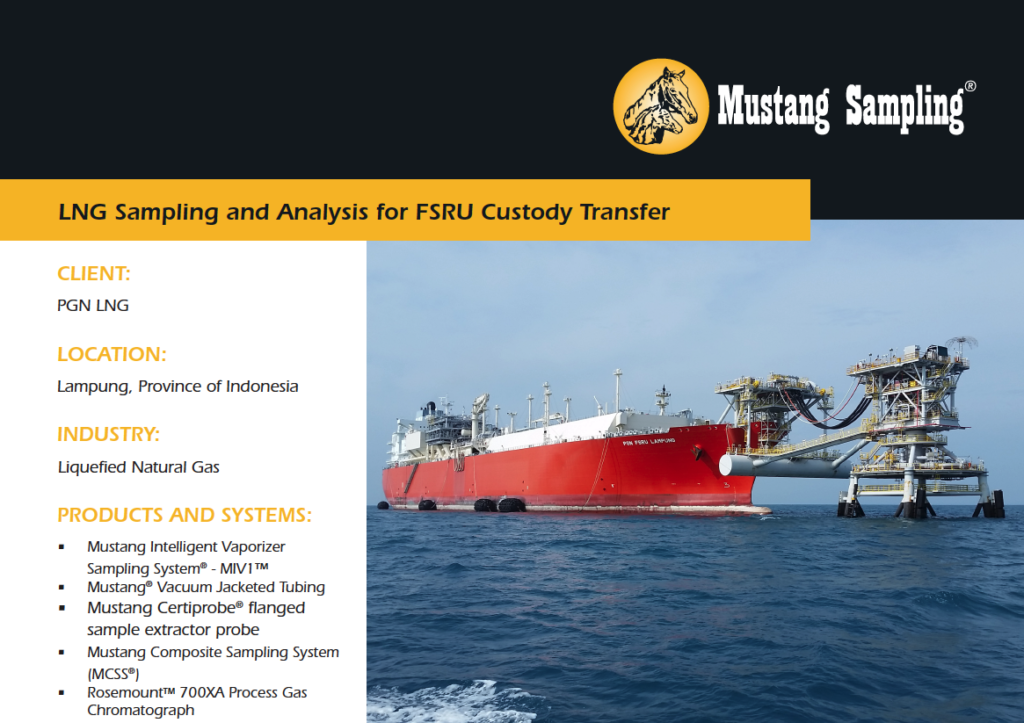CLIENT:
PGN LNG
LOCATION:
Lampung, Province of Indonesia
INDUSTRY:
Liquefied Natural Gas
PRODUCTS AND SYSTEMS:
- Mustang Intelligent Vaporizer Sampling System® – MIV1®
- Mustang® Vacuum Jacketed Tubing
- Mustang Certiprobe® flanged sample extractor probe
- Mustang Composite Sampling System (MCSS®)
- Rosemount™ 700XA Process Gas Chromatograph
THE BACKGROUND
Since July 2014, PGN LNG has been operating Heogh’s Floating Storage Regasification Unit (FSRU) located 21km off shore from Labuhan Maringgai – Lampung. The ship’s capacity of 1.2 MTPA with delivery limits up to 240 MMSCFD is critical to the local supply of natural gas in Southern Sumatra, Indonesia. The FSRU Lampung has a length of 294 meters, width of 46 meters and weight of 81,900 tons. The FSRU receives LNG from Tangguh in Bintuni Bay, West Papua, which is operated by BP, regasified, and then transported to onshore area via PGN’s gas pipeline along 90 kms.
THEIR CHALLENGE
The composition of LNG varies considerably depending on its source, storage, and age. Since cargos are typically traded per total energy content, the value of the fuel increases or decreases as the composition of the LNG changes. The fuel may also become unsuitable for some applications if the portion of methane, or “methane number”, falls outside certain ranges.
Offshore applications create unique and difficult challenges especially in the sampling and analysis of LNG while both loading and unloading the fuel.
Low pressure LNG supply
- Pressure to transfer LNG may be less than 0.5 barg
- Pump pressure may be unstable
- Pulsations within supply pressure may cause liquid and gas surging
Transfer time periods are shorter than large scale custody transfer
- Stable Sample Time is difficult to establish
- Sampling must take place reliably with little or no prior notice
- Analysis Cycle Time is critical so the analyzer must be ready at all times
LNG composition variations are significantly larger than large scale operations
- LNG loads may not be single sourced
- Aging in tanks is considerable compared with terminal-to-terminal voyages
- Ship consumption of LNG constantly changes liquid composition
- Partial shipments dilute the LNG storage tanks and change the overall composition
- Delivery of “off-spec” LNG is not uncommon
Data storage and auditing requirements demand accurate record keeping
- System host computer must meet logging requirements globally
- System host computer must be secure but accessible
- System host computer must be interchangeable with industry standards
- Units of measurement must be flexible and selectable
Sampling System must be simple to operate and maintain
- FSRU personnel are not analyzer or custody transfer specialists
- System must be easily maintained by ship crew, especially in remote locations
- Sample storage containers should be easily sourced globally
- Sampling system must meet marine environmental standards
MUSTANG SAMPLING’S COMPLETE CUSTODY TRANSFER SAMPLING SOLUTION.
Mustang Sampling developed a system to determine and store compositional data and energy values, along with samples, during LNG transfers. The system is fully compliant to ISO 8943 and follows all GIIGNL LNG Custody Transfer Handbook recommendations. The system can operate at pressures as low as 0.7 barg and is highly configurable.
A Mustang Certiprobe® flanged sample extractor probe, designed to meet all international standards, is the initial access point. The gas sample travels to the Mustang Intelligent Vaporizer Sampling System® – MIV1® via Mustang® Vacuum Jacketed Tubing which insures sample integrity with no prevaporation of liquid. The multistage patented technology system of the MIV1 is designed with enhanced sample quality, through controlled vaporization, accumulation which eliminates pulsations and homogenization. Fresh samples are provided to a continuous online analyzer and gas chromatograph (GC) for online analysis as transfer takes place as well as a Mustang Composite Sampling System (MCSS®) that provides custody transfer samples as required within multiple spot and composite sample containers.


